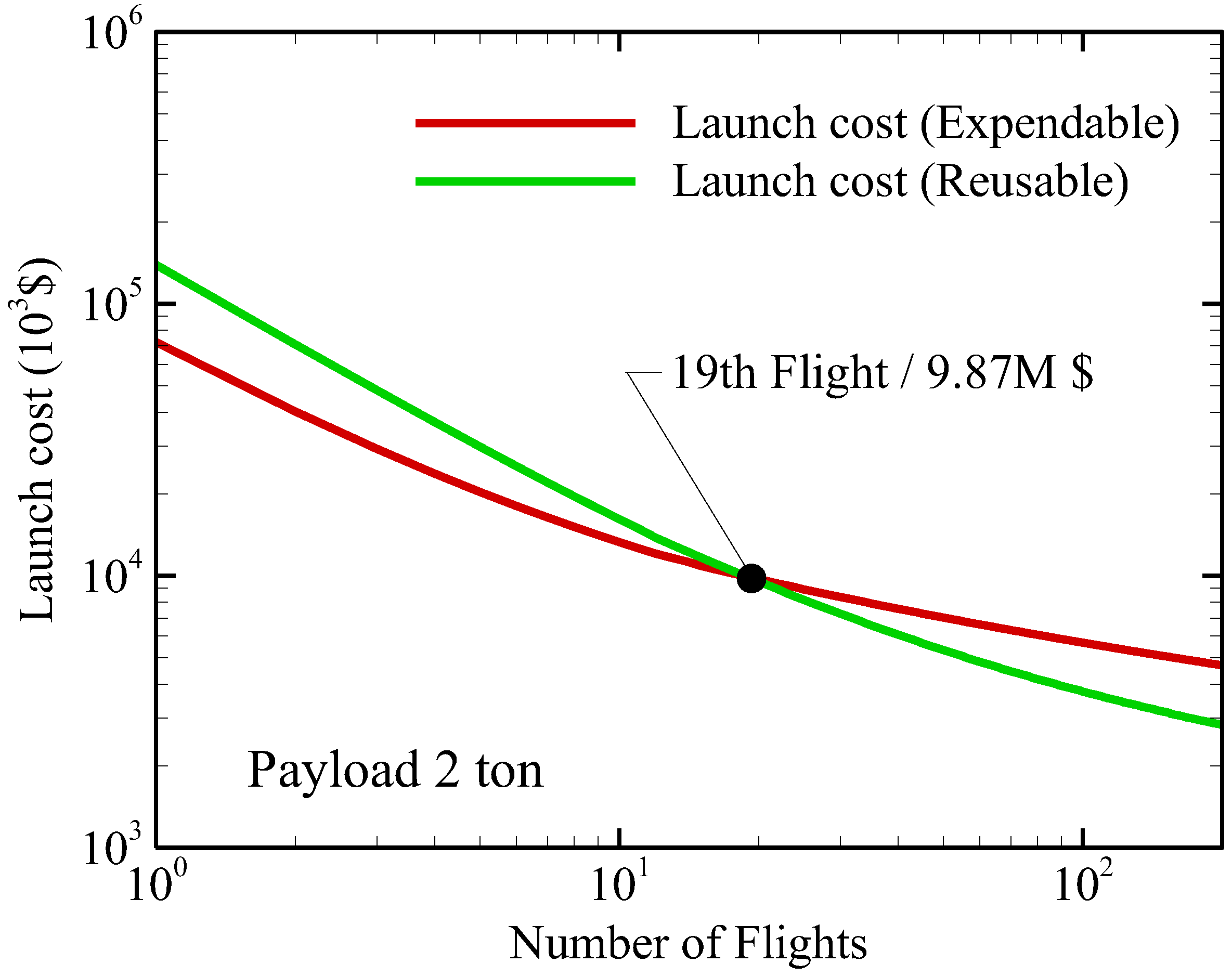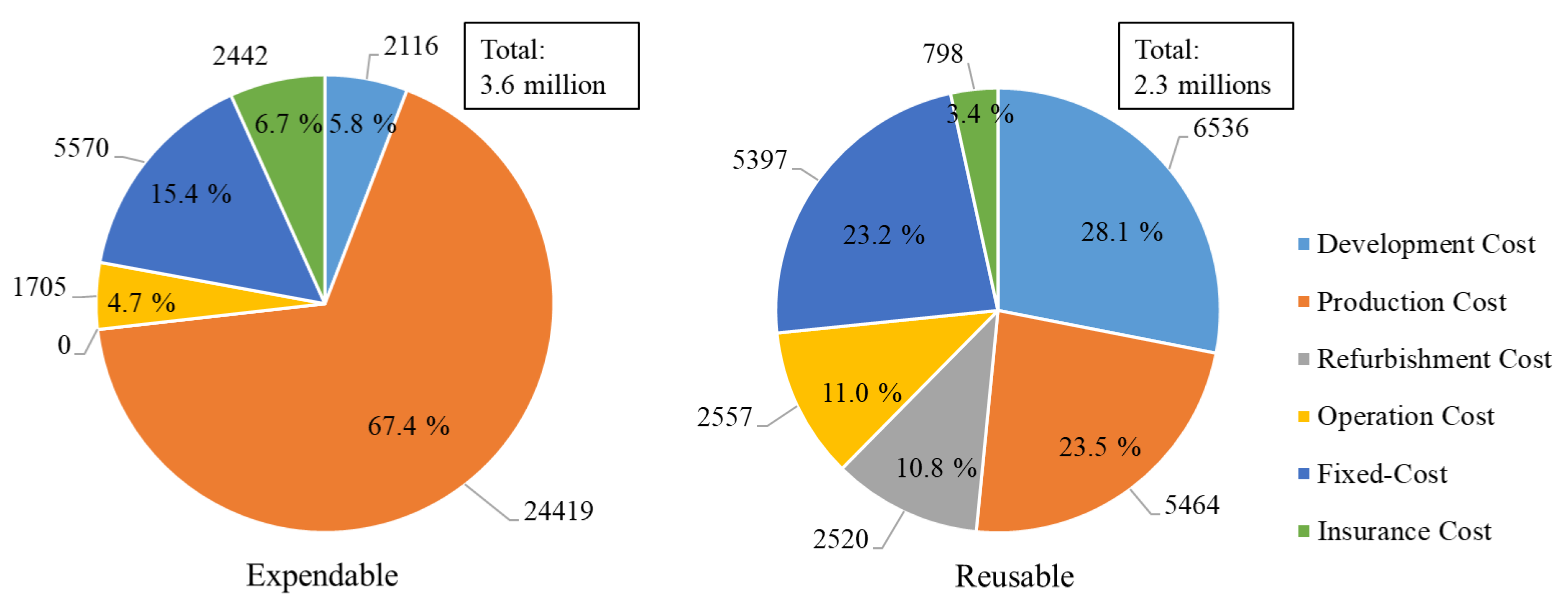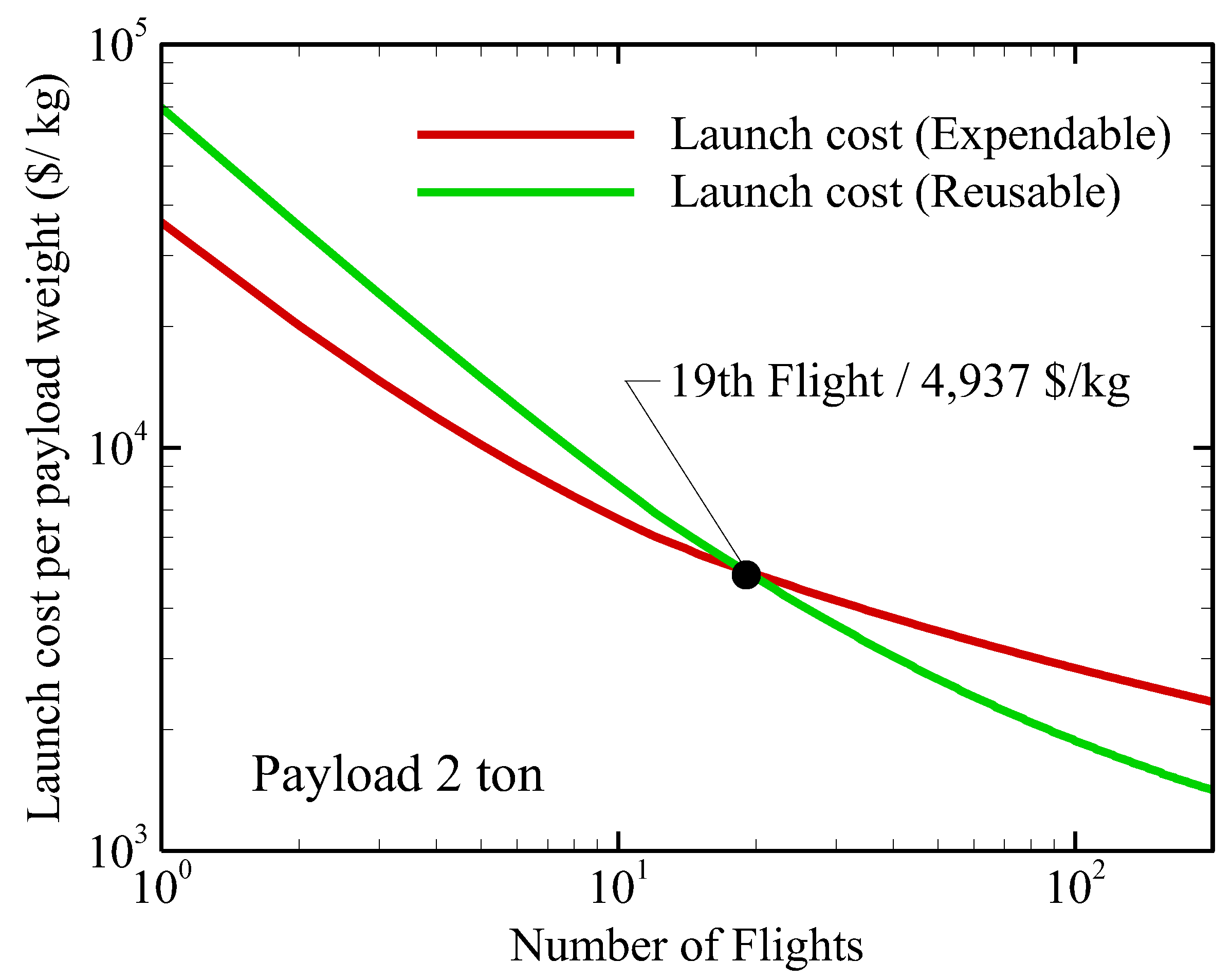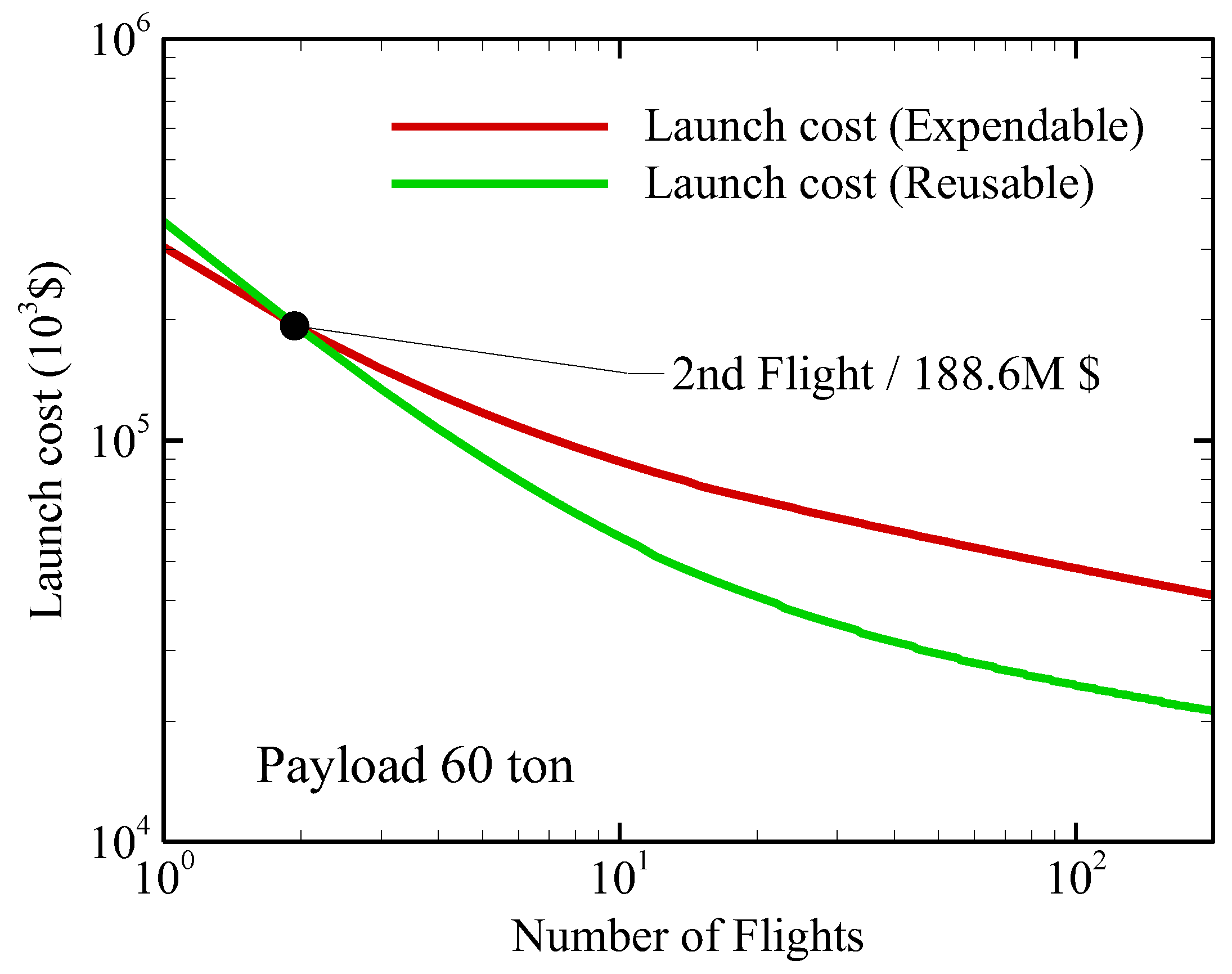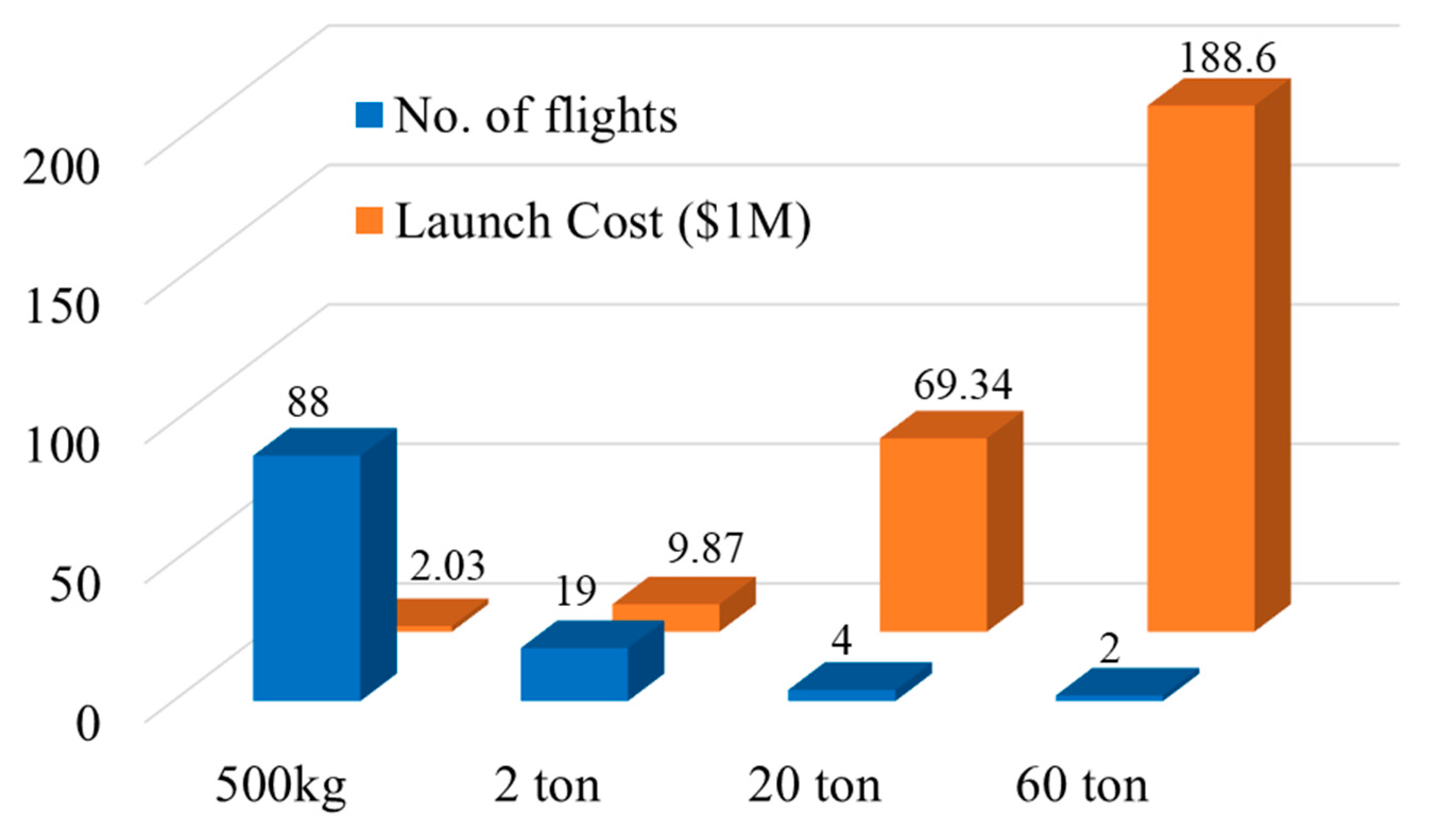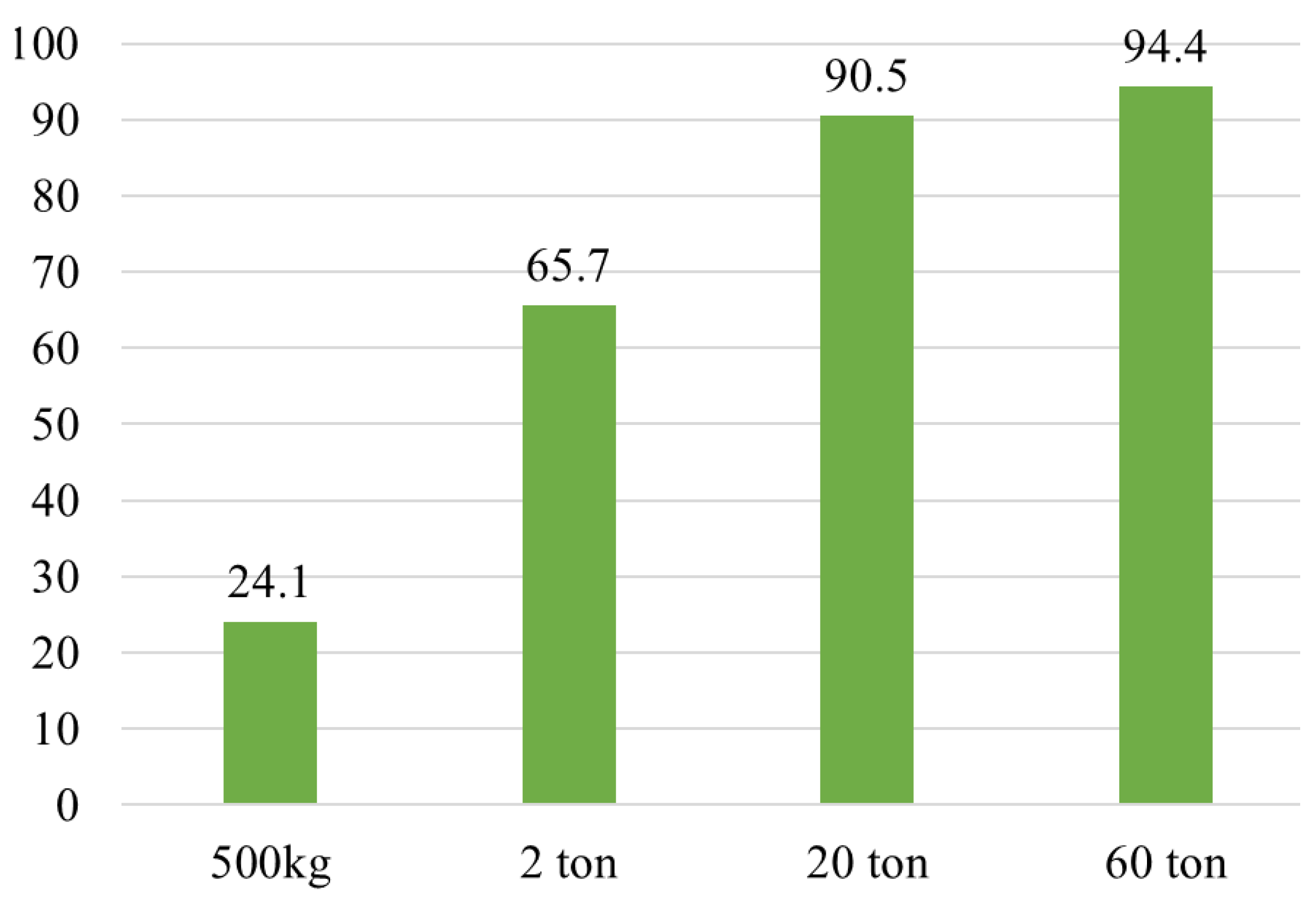1. Introduction
Over the past few years, South Korea’s space development has achieved notable progress, with the successful development of the Nuri (Korea Space Launch Vehicle, KSLV-II) space launch vehicle leading the way. This success has spurred further research into the rocketry field, utilizing the technology and systems of both Naro (KSLV-I) and Nuri rockets for various projects. These include studies on lunar exploration launch vehicles [
1,
2], scientific rocket missions [
3,
4], and examinations of new rocket technologies [
5]. Additionally, research based on the design of the Nuri rocket has been conducted on the conceptual design of large geostationary orbit launch vehicles [
6], improvements in Nuri rocket performance [
7], and high-performance small launch vehicles [
8,
9]. Research aimed at developing systems engineering procedures for small launch vehicles has also been carried out by the author’s research group at the graduate level [
8]. As the global launch vehicle market evolves, there is an increasing interest in reusable launch vehicles in South Korea, necessitating a thorough evaluation of the viability and utility of reusable launch vehicles.
The administrator of the Korea AeroSpace Administration (KASA) announced a policy to reduce Low-Earth Orbit (LEO) transport costs to below USD 1000 per kilogram by the 2030s, spearheaded by the Korea Aerospace Administration and the Korea Aerospace Research Institute. Shortly after, he unveiled plans to develop a partially reusable launch vehicle capable of transporting a 500 kg payload to a 500 km LEO [
10,
11]. Rocket Lab has developed a small reusable launch vehicle, Neutron [
12], that follows Electron. Despite being a small launch vehicle, it has an advantage in transporting large satellites due to its relatively large fairing and excellent engine performance. Blue Origin is developing a fully reusable suborbital small launch vehicle, New Shepard [
13], designed for space tourism and scientific research. In addition, reusable small launch vehicles using air launch, such as LauncherOne [
14], are being developed, and the development of reusable small launch vehicles is progressing rapidly worldwide. While this goal is competitive at present, some critical questions remain as to whether it will remain viable in the future, pointing out that achieving USD 1000 per kilogram with only partial reusability may be challenging [
15]. Additionally, NOVASPACE Company highlighted the limitations of small launch vehicles, noting that high costs and low launch frequency make success in the market difficult [
16]. Indeed, global space companies are concentrating on medium-to-large scale reusable launch vehicles, with SpaceX developing Starship, a fully reusable vehicle capable of heavy-lift missions.
Current trends in launch vehicle development are gravitating toward medium- and large-scale reusable vehicles. Leading companies like BlueOrigin and SpaceX benefit from established knowledge and infrastructure, enabling them to advance quickly. However, emerging spacefaring nations like South Korea face challenges due to limited experience and infrastructure. Reliable information on launch costs and efficiency remains scarce, often limited to news articles, with few academic studies available. Thus, emerging nations need to focus on understanding development scopes that are feasible within their own context rather than solely relying on foreign cases. This study aims to provide actionable insights by analyzing costs and parameters in launch vehicle development, offering practical benchmarks for emerging spacefaring nations.
Over the past 50 years, there has been an ongoing debate regarding the launch costs of satellite launch vehicles. An important part of this debate revolves around two main perspectives: one arguing that reusing satellite launch vehicles can significantly reduce launch costs, and the other asserting that the cost-saving benefits of reuse are minimal, if not leading to increased launch expenses.
A prominent program that was initiated with ambitious plans to dramatically reduce launch costs through reusability was the Space Shuttle program. It commenced in 1972 with the submission and approval of a proposal to the U.S. Congress, outlining the vision of launching once a week, achieving up to 100 reuses, and having a 10-year lifespan while bringing down launch costs to USD 118 per pound (in 1972). The Space Shuttle development began in 1972 and successfully completed its first launch in 1981. However, the actual launch costs ended up being significantly higher than the initial plans. Moreover, the program suffered two major accidents and eventually concluded in 2011.
When compared with the costs in 2011, the expenses of the Space Shuttle launch amounted to approximately USD 450 million, which is roughly four times higher than conventional launch vehicles. When considering the total development and operational costs of the Space Shuttle program, the average launch cost per launch was around USD 1.5 billion, which equates to USD 60,000 per kilogram of payload [
17,
18,
19].
The belief that reusable launch vehicles were not economically viable, which drew lessons from the Space Shuttle program, was prevalent until the early 2010s. However, the entry of SpaceX, a private company, into the satellite launch market with successful reusable launch vehicles in the early 2000s reignited the debate surrounding the launch costs of reusable vehicles. SpaceX initiated the development of reusable launch vehicles in 2011, and by 2016, they successfully achieved the recovery of the first stage in commercial satellite launches. They have also announced their ambition to reduce satellite launch costs to one-tenth of the current level.
Prominent experts advocating for reusable launch vehicles, such as SpaceX’s Elon Musk, have asserted that if reusable launch vehicles are developed along the lines of current aircraft, launch costs could potentially decrease to 1/100 of their current levels [
20]. On a similar note, Jeff Bezos of Amazon has also argued that reduced launch costs through reusable launch vehicles could lead to rapid advancements in the space market, akin to the growth of the internet market [
21]. Conversely, Stephen Israel of Arianespace, who holds a less favorable view towards reusable launch vehicles, has stated that the cost-effectiveness of reusable launch vehicles is contingent on the number of launches. According to current projections in the satellite launch market, it is not clear whether reusable launch vehicles hold a distinct advantage [
22,
23]. Hence, it is anticipated that this debate will persist for a considerable period, with the relative merit of reusable launch vehicles hinging on advancements in technology and the growth trajectory of the satellite launch market.
The cost estimation analysis technology is crucial, as launch costs are highly correlated with the market for space activities and launch vehicle technologies. In the late 1960s, the TRANSCOST space transportation cost model was developed, which divided launch costs into various factors and estimated them using cost estimation relationships (CERs) [
24]. Subsequently, through the cost analysis of various configurations of future European launch vehicles, the model demonstrated its availability and scalability, enhancing the reliability of launch cost estimation models [
25]. In addition to the TRANSCOST model, various launch cost estimation methods and optimization techniques applicable to the global aerospace industry have been researched [
26,
27,
28,
29,
30,
31,
32] based on CER. Chang et al. provided higher accuracy in cost estimation by introducing additional parameters such as cost adjustment factors and adjustment coefficients [
33]. Crawford et al. addressed the shortcomings of simple relationships and emphasized the importance of establishing detailed relationships, discussing specific cost analysis methods and cost control techniques [
34].
As part of this study, we conducted a comparative analysis of launch costs between reusable and traditional launch vehicles based on the current technological state. Furthermore, we investigated how important cost factors influence launch expenses. Through this research, we aim to provide guidance on the development of launch vehicles to secure competitiveness in the future satellite launch market.
2. Method of Launch Cost Estimation
The exact values of launch costs are challenging to determine in the current satellite launch market because they are not publicly disclosed by the companies involved, and most companies do not provide such information. As observed in
Table 1, the lower launch prices for launch vehicles in Eastern countries, such as Russia, are believed to be a result of policy support for domestic launch systems. In the case of most past launch vehicles, excluding SpaceX, it is estimated that launch prices were determined, excluding development costs since they were developed under a state-led development regime where the entire development cost was covered by the government.
In this study, launch costs are calculated by dividing them into six distinct categories: development costs, manufacturing costs, reuse costs, operational costs, fixed costs, and insurance costs, all of which are inclusive of all expenses associated with the launch. Financial costs and corporate profits are not included in the calculation of launch costs. Therefore, the determination of launch prices is influenced by a company’s business strategy, among other factors. The cost estimates used in this study are at a rough order of magnitude (ROM) level, and cost estimation relationships (CERs) are employed to calculate these costs. The CERs used in the cost model are based on widely recognized CERs like TRANSCOST and NAFCOM [
35], and the coefficients used in the cost model are determined by reflecting current technological levels and various publicly available data obtained through the internet [
36,
37,
38,
39,
40]. In this study, the cost estimation relationship is based on “Man-Years”, and the costs were calculated using the 2019 U.S. engineering Man-Year rate as a reference.
In addition to the references, correction factors were estimated using online information such as news articles and SNS, but some of this information is not published in the literature and could not be cited as references. The range of reliability of this information would be controversial, since the price information depends on various factors, and it is impossible to predict accurately. However, it is believed to be sufficient to support the results of this paper, which predicts trends of dependency on the payload capacity of launch vehicles in a large range.
Table 1.
Theoretical launch price per kilogram of selected launch systems [
41].
Table 1.
Theoretical launch price per kilogram of selected launch systems [
41].
| Nation | Launch Vehicle | Payload (kg) | Launch Price (USD/kg) |
|---|
| USA | Atlas V | 18,800 | 8100 |
| Falcon 9 | 22,800 | 3059 |
| Falcon 9 (Reusable) | 18,500 | 2702 |
| EU | Ariane 6 | 21,700 | 5300 |
| Russia | Proton-M | 23,000 | 2800 |
| Japan | H2B | 16,500 | 6800 |
| China | LM 7 | 13,600 | 5100 |
2.1. Development Cost
The development costs of satellite launch vehicles are sometimes calculated separately for stages, and engines may be assessed as distinct cost components. The calculation methods vary depending on the cost model in use. In most cost models, development costs are calculated based on their relationship with the structural mass of the launch vehicle. However, for the purpose of this study, which aims to compare launch costs for launching the same satellite into the same orbit regardless of the characteristics of the launch vehicle, development costs are expressed as a function of the mission payload, as shown in Equation (1).
Here, the factor of “
n” varies slightly depending on the cost model, but for this study, we used a value of 0.55. Additionally, the development costs vary depending on factors such as the technological maturity of the target, the cost-effectiveness of the development approach, the experience of the development team, and the working environment based on the developing country. Therefore, coefficients that can account for these considerations are applied to calculate Equation (2).
In this equation, the proportionality constant has been modified from cost models based on structural mass to mission payload, ensuring that the same development cost is calculated [
42].
To enable the reusability of satellite launch vehicles, the concept of reusability needs to be integrated from the design phase, necessitating different material selections and considerations. As a result, the development cost increases compared to traditional launch vehicles, which are used once and then discarded. In particular, as evident in the development of reusable launch vehicles by SpaceX, numerous flight tests are required for recovery. Furthermore, the difficulty of the technology and the associated costs increase with the number of potential reuses. Therefore, the development costs of a reusable launch vehicle are calculated, considering these additional expenses, as shown in Equation (3).
In this equation, the proportionality constant and other constants are adopted from TRANSCOST’s cost model [
42]. The exponential constant, considering the baseline of ten reuses and the doubling of development costs for a launch vehicle capable of a hundred reuses, is set at 0.3.
Development costs are typically amortized or spread over a certain period, and this duration can vary. Therefore, the annual amortization cost depends on how many years it takes to amortize the development cost, accounting for inflation rates. Hence, the annual amortization cost for development expenses is calculated using Equation (4).
In this equation, “y” represents the amortization period, and “e” is the annual average inflation rate.
2.2. Manufacturing Cost
The manufacturing costs of satellite launch vehicles are computed based on the chosen cost model, much like development costs. Additionally, some cost models segregate engine costs separately. In most cost models, these costs are calculated based on their relationship with structural mass. However, to align with the objectives of this study, as described for development costs, manufacturing costs are computed based on their relationship with the mission payload, as expressed in Equation (5) below.
In this equation, the exponential constant and the proportionality constant are adapted based on values modified from TRANSCOST’s cost model [
42].
The manufacturing costs calculated using Equation (5) represent the production cost of the first manufactured launch vehicle. However, as the production quantity increases, manufacturing costs decrease incrementally. To account for this, a Learning Curve is typically applied, as shown in Equation (6) [
43].
Here, “” represents the production cost of the “n” the manufactured launch vehicle, “” is the production cost of the first manufactured launch vehicle, and “” is the Learning Curve Factor, typically ranging from 0.85 to 0.95, depending on the production environment.
Similarly to development costs, manufacturing costs for reusable launch vehicles significantly increase compared to traditional launch vehicles, and they also increase with the number of reuses. To accommodate such cost escalation, manufacturing costs for reusable launch vehicles are calculated using Equation (7).
2.3. Reuse Cost
Reuse costs include all the expenses associated with refurbishing, inspecting, and testing the recovered launch vehicle to restore it to a condition suitable for reuse. Excessive reuse costs can diminish the cost-effectiveness of reusable launch vehicles. Notably, in the case of the Space Shuttle, these costs exceeded the initial projections and played a significant role in the program’s overall failure.
Determining the appropriate reuse costs is a challenging aspect of cost analysis, and when developing reusable launch vehicles, managing reuse costs becomes a critical goal. In this study, reuse costs are based on the production cost of the first manufactured launch vehicle.
Furthermore, as the practice of reuse continues, the need for repairs and inspections naturally increases, leading to an escalation in inspection and testing expenses. This cost increase can be factored in using a Learning Curve, as depicted in Equation (6). The Learning Curve Factor employed for assessing reuse costs typically falls within the range of 1.1 to 1.2, accounting for this effect.
2.4. Operational Cost
The launch of a rocket involves several stages, starting with the transportation of the launch vehicle, assembly at the launch site, the final integration of the payload, and the various procedures on launch day, all of which require significant manpower and expenses. Additionally, the program’s management, flight operations, mission planning, and post-launch activities such as flight path tracking and management are also essential.
The sum of all the expenses required to perform these tasks is referred to as operational costs. Operational costs also encompass consumables such as propellants and oxidizers.
These costs tend to increase with the size of the launch vehicle, as the vehicle’s size is directly proportional to the payload size. Operational costs can be calculated as shown in Equation (8).
In this context, the exponential constant is established at 0.75, based on estimates from the TRANSCOST cost model. Additionally, to define the reference payload mass “
” as 22 tons and to appropriately set the required operational cost “
” for launching it, publicly available data on 20-ton-class launch vehicles such as Atlas V, Ariane 6, Falcon 9, and others were used as a basis. This approach is implemented with the expertise of an expert in the field of launch vehicles and cost analysis [
36,
37,
38,
39,
40].
Operational costs also benefit from a synergy effect as the number of launches increases. With more launch experiences, increased operator expertise, and reduced consumables costs, operational costs tend to decrease slightly. This effect can be accounted for by using a Learning Curve Factor in the range of 0.9 to 0.95.
While the operational costs for reusable launch vehicles are not expected to differ significantly from conventional launch vehicles, the costs associated with post-launch recovery for reusable launch vehicles are expected to be considerable. Therefore, operational costs for reusable launch vehicles are set at 1.5 times the operational costs calculated using Equation (7).
2.5. Fixed Cost and Insurance Cost
Typically, the company manufacturing the launch vehicle and the company providing launch services may be different entities. However, companies like SpaceX manage the entire process from manufacturing the launch vehicle to conducting launches. In the case of SpaceX, not only do they have production facilities, but they also possess their own launch facilities. Therefore, the costs associated with maintaining and operating production facilities and launch sites are incurred irrespective of whether a launch occurs or not. These costs must encompass depreciation costs related to investments in production facilities and launch site equipment. Additionally, they should include the salaries of the minimal workforce required to maintain production facilities and launch sites efficiently.
The fixed costs of production facilities are influenced by the scale of the facilities. The facility’s scale is tied to the size of the launch vehicle being produced and the annual production quantity. To account for these effects, the fixed costs of production facilities can be calculated as shown in Equation (9).
Here, the exponential constant is set at 0.63 under the assumption that a threefold increase in production output and launch vehicle size could lead to a double increase in production facility size. The reference for these fixed costs is set with a payload mass of 22 tons, production personnel working two shifts, and an annual production quantity capped at 18 launch vehicles.
The fixed costs of launch facilities vary with the facility’s scale and are predominantly determined by the annual launch frequency. Additionally, the size of the launch vehicle has some influence on these costs. The fixed costs of launch facilities can be calculated as shown in Equation (10).
Here, the reference payload is set at 22 tons, with an annual launch frequency of 12 times. The exponential constant is assumed to be 0.2 under the premise that if the size of the launch vehicle doubles, the launch facility’s size would increase by approximately 15%. Considering that with an annual launch frequency of 180 times, there should be about six launch pads, the assumption is made that the launch facility’s size should double, leading to an exponential constant of 0.256.
Insurance costs are calculated at 10% of the average manufacturing cost of the launch vehicle for convenience in cost estimation. These costs take into consideration reliability, including the launch failure and other factors assessed by insurance companies when determining the specific insurance rates.
3. Discussions on the Results of the Cost Estimation
The selection of targets for the analysis of the launch costs of reusable launch vehicles and conventional launch vehicles should be the most suitable launch vehicles to validate the cost calculation results. Since currently only SpaceX’s Falcon 9 has successfully performed launches as a reusable launch vehicle, Falcon 9, with a payload mass of 18.5 tons, was selected as the reference launch vehicle for cost analysis. The necessary calculation parameters for cost analysis were determined based on various papers and publicly available information on the internet. Additionally, the orbit to which the launch vehicle delivers satellites is based on LEO at a 200 km circular orbit, which is used for comparing launch costs. It is practically the lowest LEO used commonly to compare the launch capabilities.
The Falcon 9 first-stage booster has already recorded 26 reuses, and the fairing has also recorded more than 20 reuses. There are various variables for reuse, and parametric studies or sensitivity analyses for these variables can strengthen the contents of cost estimation. However, they are beyond the scope and purpose of the present study and should be considered as the next step of research. Since reuse is still a challenging goal for launch vehicles other than Falcon 9, this study analyzed and discussed the fixed value of 10 reuses, which is determined based on current technological capabilities. Although the size of the launch vehicle remains the same, the reusable launch vehicle’s payload mass decreases by approximately 30% by saving the fuel and oxidizer required for the return flight because the unused propellant is nothing but a structural mass during the acceleration and ascent.
As described above, the estimated values for various coefficients required for calculating launch costs are determined based on several sources, including papers and online materials related to similar launch vehicles with a payload mass of 20 tons, such as Falcon 9, as shown in
Table 2 and
Table 3 [
36,
37,
38,
39,
40]. The results of this study were reanalyzed using Yang’s data [
44,
45], which is several years old but would not affect the overall trends of the effectiveness of launch vehicles depending on the payload capacity.
The results of the cost calculation for launching satellites using various launch vehicles with a payload mass of 20 tons are illustrated in
Figure 1. As shown in the figure, when the annual launch frequency is low, the launch cost of reusable launch vehicles is higher. However, as the annual launch frequency increases, the cost-effectiveness of reusable launch vehicles becomes more pronounced. For example, for an annual launch frequency of 20 launches, the launch cost of a reusable launch vehicle is approximately 64% of expendable launch vehicles, reducing the cost to around USD 23 million. For an annual launch frequency of 200 launches, the cost-effectiveness becomes even more pronounced, with the cost per launch decreasing to approximately 52%, which is around USD 10 million.
Considering that SpaceX’s Falcon 9 conducts around 100 launches annually [
46], the calculated launch costs align with estimations from various publicly available data and the literature. Therefore, the proposed cost calculation method in this study appears to be appropriate for estimating ROM costs.
When analyzing the launch costs for 20-ton launch vehicles with a frequency of 20 launches per year, the costs are broken down into six categories, as shown in
Figure 2. The unit is 10
3 USD. For expendable launch vehicles, the manufacturing cost of the launch vehicle represents the largest portion, approximately 67%. Fixed costs associated with production facilities and launch sites account for about 15% of the total cost. In contrast, for reusable launch vehicles, development costs are about 28%, manufacturing costs are approximately 24%, and fixed costs associated with production facilities and launch sites represent around 23% of the total cost. Reuse costs and operational costs make up approximately 11% each. Unlike expendable launch vehicles, reusable launch vehicles require a lot of new technology, effort, cost, and time to design, test, and verify the new reusable system, and additional reuse costs such as transport, inspection, and maintenance for reuse are added.
The results, converted into cost per unit mass of the payload, are depicted in
Figure 3. Due to the 30% reduction in payload mass of the reusable launch vehicle compared to the conventional one, the cost-effectiveness of the reusable launch vehicle is slightly less when measured per launch. In other words, for an annual frequency of 20 launches, the launch cost is approximately 92% relative to the conventional launch vehicle, amounting to USD 1663 per kilogram. In the case of 200 launches per year, the launch cost becomes about 75%, equating to USD 756 per kilogram, as observed. This analysis is presented with the expertise of a specialist in the field of launch vehicles and cost analysis.
To assess the impact of payload mass on launch costs, a comparative analysis of launch costs for a small launch vehicle in the two-ton payload class was conducted, as illustrated in
Figure 4. In this scenario, the reusable launch vehicle exhibited a reduced payload mass of approximately 1.4 tons.
The results of the calculations show that when the annual launch frequency is less than 20 launches, reusable launch vehicles tend to have higher launch costs. This suggests that the cost-effectiveness of reusable launch vehicles diminishes with smaller launch vehicles. This effect is more pronounced when examining the cost per unit payload, as shown in
Figure 5.
For small launch vehicles with a two-ton payload mass, the cost-effectiveness of reusability only becomes evident when conducting over 70 launches annually. Even with an annual launch frequency of 200 launches, there is only a modest cost reduction of approximately 14% compared to expendable launch vehicles.
When examining the cost-effectiveness of reusable launch vehicles with respect to very heavy payload mass, a comparative analysis was conducted for a payload mass of 60 tons. The results of this analysis are depicted in
Figure 6.
In the case of a 60-ton payload, with an annual launch frequency set at 20, the launch cost decreases to approximately USD 41 million, which is about 57% of the cost of conventional launch vehicles. Furthermore, with an annual launch frequency of 200, the cost can decrease to as low as USD 21 million. When comparing the cost per unit payload for a 60-ton payload, it is illustrated in
Figure 7. In this scenario, due to the 30% reduction in payload mass for reusable launch vehicles, the cost difference is slightly reduced compared to traditional launch vehicles.
Figure 8 illustrates the cost difference between reusable launch vehicles and expendable launch vehicles for an annual single launch. For a payload mass of 500 kg, the expendable launch vehicle is approximately 2.5 times less expensive compared to the reusable one. The ratio of the cost difference, defined as the difference divided by the expendable launch cost, is plotted in
Figure 9. As the payload mass increases, the price gap between the two narrows, and for payloads of 60 tons, the price difference is only around 15%. This demonstrates that even for an annual single launch, a larger payload capacity can provide cost advantages for reusable launch vehicles.
The break-even points for various payload masses can be observed in
Figure 10. For payload masses of 500 kg and two tons, the break-even points occur at 88 and 18 launches, respectively. These results indicate that reusable launch vehicles offer advantages when a relatively large number of launch missions are considered compared to the earlier calculations. For a clear comparison, the cost-effectiveness of reusable launch vehicles is defined as the cost difference divided by the reusable launch cost for the 200th flight.
Figure 11 illustrates the cost-effectiveness of reusable launch vehicles compared to expendable launch vehicles across payload masses of 500 kg, 2 tons, 20 tons, and 60 tons. This demonstrates that as the payload increases, the effectiveness of reusable launch vehicles becomes more prominent.
4. Conclusions and Policy Implications
This study has provided rough order of magnitude (ROM) estimates of launch costs for satellite launch vehicles. These estimates are considered reasonable based on an indirect comparison with available data and are suitable for comparative analysis across a range of payload sizes.
The research reveals that annual launch frequency has the most significant impact on launch costs for both reusable and expendable launch vehicles. As the annual launch frequency increases, the cost-effectiveness of reusable launch vehicles becomes more apparent. Furthermore, it is worth noting that the cost-effectiveness of reusable launch vehicles shows a slight decrease in terms of the cost per payload mass rather than cost per launch.
Another crucial factor affecting the cost-effectiveness of reusable launch vehicles is the size of the payload. When the payload mass is small, i.e., when the launch vehicle is of modest size, the cost-effectiveness of reusable launch vehicles diminishes. Conversely, as the payload capacity increases, the cost-effectiveness of reuse improves. In other words, for small launch vehicles, unless the annual launch frequency is exceptionally high, it is more cost-effective to use traditional expendable launch vehicles. Therefore, applying the concept of reusability to small launch vehicles requires careful consideration.
While this study did not compare different levels of reusability, it is important to consider the number of times a launch vehicle can be reused as a critical factor in determining cost-effectiveness. In this research, we assumed there was a fixed number of reuses, setting it at 10 times, taking into account the current technological level. However, it is worth noting that as the number of reuses increases, launch costs will gradually decrease. Furthermore, minimizing the expenses associated with refurbishment, inspection, and testing for reusability will be a vital factor in enhancing the cost-effectiveness of reusable launch vehicles. In essence, if the costs associated with maintenance and testing are reduced to the level of contemporary aircraft operations, the utility of reusable launch vehicles would significantly increase.
Another critical factor influencing the cost-effectiveness of reusable launch vehicles is the development and production costs. If the expenses required for developing reusable launch vehicles become prohibitively high or if the costs associated with manufacturing them substantially increase, it could lead to a significant reduction in cost-effectiveness. Paradoxically, this could result in reusable launch vehicles being more expensive than their expendable counterparts. Until the early 2000s, numerous studies reflected on this sentiment, suggesting that overly high-cost estimates for the development and production of reusable launch vehicles hampered their cost-effectiveness when compared to traditional expendable launch vehicles.
In summary, the concept of reusability for launch vehicles is a valuable approach to reducing launch costs, but it should be carefully evaluated, considering various cost factors. The effectiveness of reusability depends on a combination of factors, including annual launch frequency, payload size, and the number of reuse cycles. Decisions related to development and production costs are crucial in determining the overall cost-effectiveness of reusable launch vehicles. This study aims to provide practical guidance for emerging space-faring nations by analyzing the costs and key parameters essential for launch vehicle development. Through the use of qualitative metrics, this study seeks to deliver actionable insights that can assist in formulating effective launch vehicle development policies. This study confirms that cost-effectiveness depends on careful consideration of these factors.
